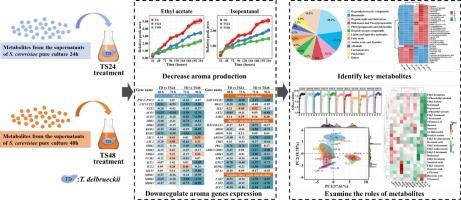揭示酵母的相互作用:洞察酿酒酵母代谢物在葡萄酒发酵过程中调节德尔布鲁奇托鲁菌香气生物合成中的作用
IF 5.2
1区 农林科学
Q1 FOOD SCIENCE & TECHNOLOGY
International journal of food microbiology
Pub Date : 2025-08-31
DOI:10.1016/j.ijfoodmicro.2025.111415
引用次数: 0
摘要
酿酒酵母和非酿酒酵母之间通过分泌代谢物的相互作用在形成葡萄酒的香气特征中起着至关重要的作用,但其潜在的机制尚未得到充分的了解。本研究采用细胞/培养基分离策略,结合转录组学和代谢组学分析,阐明酿酒酵母代谢物对葡萄酒发酵过程中Torulaspora delbrueckii香气生物合成的影响。结果表明,酿酒酵母代谢物抑制了delbrueckii的生长,抑制了几种关键挥发性化合物的产生,包括乙酸乙酯、丁酸乙酯和2-苯乙醇。转录组分析显示,delbrueckii参与香气合成途径的重要基因EHT1/EEB1、ARO10、ADH3、HOM2、FAS1和FAS2显著下调。非靶向代谢组学分析鉴定了867种代谢物,其中5种来自酿酒酵母的代谢物差异显著地影响了delbrueckii的香气形成。值得注意的是,腺苷(ADO)、甘油酰胆碱(GPC)和2-羟基异己酸(HIA)增加了癸酸乙酯(237.63%)和2-苯乙醇(29.06%)的产量,而n -辛烷酰甘氨酸(NOG)增加了辛酸乙酯(229.29%)和辛酸(219.36%)的产量。重要的是,吲哚-3-羧醛(ICA)对delbrueckii的生长有显著的抑制作用,并降低了大多数香气化合物的浓度。这些发现为葡萄酒发酵过程中酵母之间的代谢相互作用提供了新的见解,并为酿酒师提供了有针对性地调节葡萄酒芳香特性的策略方法。本文章由计算机程序翻译,如有差异,请以英文原文为准。

Unveiling the yeast interaction: Insights into the role of Saccharomyces cerevisiae metabolites in regulating Torulaspora delbrueckii aroma biosynthesis during wine fermentation
The interactions between Saccharomyces cerevisiae and non-Saccharomyces yeasts through secreted metabolites play a crucial role in shaping wine aroma profiles, yet the underlying mechanisms remain inadequately understood. This study used a cell/medium separation strategy coupled with transcriptomic and metabolomic analyses to elucidate the influence of S. cerevisiae metabolites on aroma biosynthesis in Torulaspora delbrueckii during wine fermentation. Results demonstrated that S. cerevisiae metabolites inhibited the growth of T. delbrueckii and suppressed the production of several key volatile compounds, including ethyl acetate, ethyl butanoate, and 2-phenylethyl alcohol. Transcriptome analysis revealed significant downregulation of essential genes involved in aroma synthesis pathways in T. delbrueckii, particularly EHT1/EEB1, ARO10, ADH3, HOM2, FAS1, and FAS2. Untargeted metabolomic profiling identified 867 metabolites, with five differentially produced metabolites from S. cerevisiae significantly affecting aroma formation in T. delbrueckii. Notably, adenosine (ADO), glycerophosphocholine (GPC), and 2-hydroxyisocaproic acid (HIA) enhanced the production of ethyl decanoate (237.63 %) and 2-phenylethyl alcohol (29.06 %), while N-octanoylglycine (NOG) increased the production of ethyl octanoate (229.29 %) and octanoic acid (219.36 %). Importantly, indole-3-carboxaldehyde (ICA) exhibited significant inhibitory effects on T. delbrueckii growth and reduced concentrations of most aroma compounds. These findings provide novel insights into the metabolic interactions between yeasts during wine fermentation and offer winemakers strategic approaches for the targeted modulation of wine aromatic characteristics.
求助全文
通过发布文献求助,成功后即可免费获取论文全文。
去求助
来源期刊
CiteScore
10.40
自引率
5.60%
发文量
322
审稿时长
65 days
期刊介绍:
The International Journal of Food Microbiology publishes papers dealing with all aspects of food microbiology. Articles must present information that is novel, has high impact and interest, and is of high scientific quality. They should provide scientific or technological advancement in the specific field of interest of the journal and enhance its strong international reputation. Preliminary or confirmatory results as well as contributions not strictly related to food microbiology will not be considered for publication.

 求助内容:
求助内容: 应助结果提醒方式:
应助结果提醒方式:


